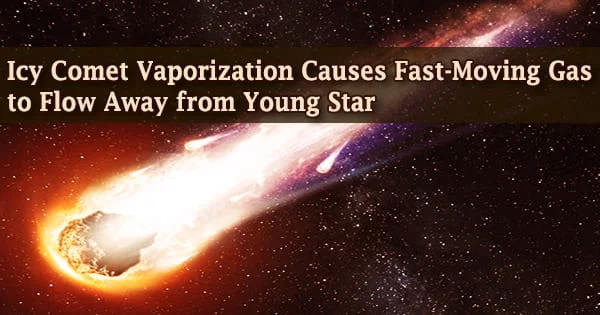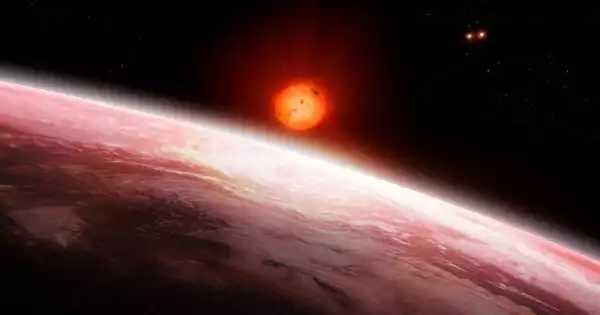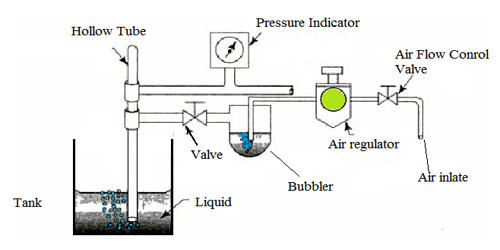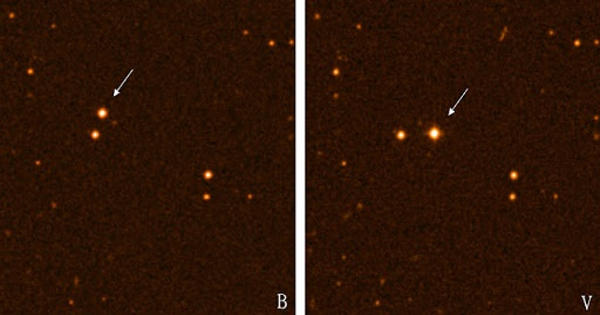Astronomers have captured a rare stage of planetary system evolution, showing fast-moving carbon monoxide gas flowing away from a star system over 400 light-years distant, a discovery that allows researchers to learn more about how our own solar system evolved.
A cometary model consisting of a CO2-dominated core plus a halo of frozen grains of H2O or clathrate hydrate explains the difference in production rates of various species with heliocentric distance in Comet West (1975n=1976 VI).
Astronomers have discovered fast-moving carbon monoxide gas flowing away from a young, low-mass star, revealing a distinct stage of planetary system creation that could shed light on how our own solar system developed and show that system development is more intricate than previously assumed.
Although it’s unclear how the gas is being ejected so quickly, a team of experts led by the University of Cambridge believes it’s caused by frozen comets vaporizing in the star’s asteroid belt. The findings will be presented at the virtual symposium Five Years After HL Tau in December.
The discovery was made with the Atacama Large Millimetre/submillimetre Array (ALMA) in Chile as part of a survey of young ‘class III’ stars that was previously published. Some of these class III stars are surrounded by debris discs, which are thought to form as comets, asteroids, and other solid objects known as planetesimals collide in the far reaches of newly formed planetary systems.
The dust and debris leftover from these collisions absorb light from their central stars and re-radiate it as a weak glow that ALMA can study.
Planet formation processes in the inner regions of planetary systems are projected to culminate in the loss of all the hottest material, leaving class IIII stars with only dim, cold dust.
These weak belts of icy material resemble known debris discs discovered around other stars, as well as our own solar system’s Kuiper belt, which is known to harbor considerably larger asteroids and comets.
Just detecting carbon monoxide gas was exciting, since no other young stars of this type had been previously imaged by ALMA. But when we looked closer, we found something even more unusual: given how far away the gas was from the star; it was moving much faster than expected. This had us puzzled for quite some time.
Joshua Lovell
The star in issue, ‘NO Lup,’ was discovered to have a faint, low-mass dusty disc in the survey, but it was also the sole class III star where carbon monoxide gas was detected, a first for this sort of young star with ALMA.
While it is well known that many young stars retain their gas-rich planet-forming discs, NO Lup is more advanced, and it is possible that it lost its primordial gas after its planets formed.
While the identification of carbon monoxide gas is unusual, the quantity and speed of the gas spurred a follow-up investigation into its movements and origins.
“Just detecting carbon monoxide gas was exciting, since no other young stars of this type had been previously imaged by ALMA,” said first author Joshua Lovell, a Ph.D. student from Cambridge’s Institute of Astronomy. “But when we looked closer, we found something even more unusual: given how far away the gas was from the star, it was moving much faster than expected. This had us puzzled for quite some time.”
The puzzle was solved by Grant Kennedy, a Royal Society University Research Fellow at the University of Warwick who led the modeling work on the paper.
“We found a simple way to explain it: by modeling a gas ring, but giving the gas an extra kick outward,” he said.
“Other models have been used to explain young discs with similar mechanisms, but this disc is more like a debris disc where we haven’t witnessed winds before. Our model showed the gas is entirely consistent with a scenario in which it’s being launched out of the system at around 22 kilometers per second, which is much higher than any stable orbital speed.”
Further investigation revealed that the gas might be formed by asteroids colliding, or during periods of sublimation, the change from a solid to a gaseous phase on the surface of the star’s comets, which are thought to be rich in carbon monoxide ice.
NASA’s New Horizons spacecraft examined the Kuiper Belt object Ultima Thule in 2019 and discovered sublimation evolution on the comet’s surface, which occurred roughly 4.5 billion years ago, providing recent proof of this same process in our own solar system.
The same event that incinerated comets billions of years ago in our own solar system may have been captured for the first time over 400 light years away, in a process that could be frequent near planet-forming stars and have ramifications for the evolution of all comets, asteroids, and planets.
“This fascinating star is shedding light on what kind of physical processes are shaping planetary systems shortly after they are born, just after they have emerged from being enshrouded by their protoplanetary disk,” said co-author Professor Mark Wyatt, also from the Institute of Astronomy.
“While we have seen gas produced by planetesimals in older systems, the shear rate at which gas is being produced in this system and its out-flowing nature are quite remarkable and point to a phase of planetary system evolution that we are witnessing here for the first time.”
While the problem isn’t completely solved, and more comprehensive modeling is needed to figure out how the gas is ejected so quickly, one thing is certain: this system will be the subject of more intensive follow-up measurements.
“We’re hoping that ALMA will be back online next year, and we’ll be making the case to observe this system again in greater detail,” said Lovell. “Given how much we have learned about this early stage of planetary system evolution with only a short 30-minute observation, there is still so much more that this system can tell us.”
















